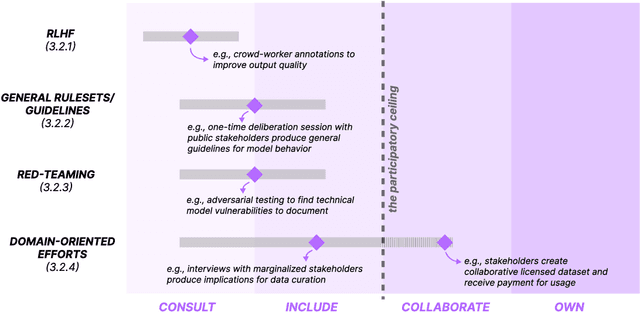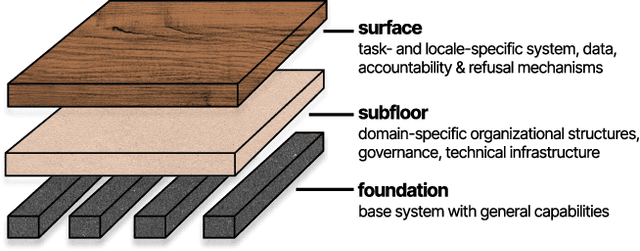Emily Tseng
"Ownership, Not Just Happy Talk": Co-Designing a Participatory Large Language Model for Journalism
Jan 28, 2025Abstract:Journalism has emerged as an essential domain for understanding the uses, limitations, and impacts of large language models (LLMs) in the workplace. News organizations face divergent financial incentives: LLMs already permeate newswork processes within financially constrained organizations, even as ongoing legal challenges assert that AI companies violate their copyright. At stake are key questions about what LLMs are created to do, and by whom: How might a journalist-led LLM work, and what can participatory design illuminate about the present-day challenges about adapting ``one-size-fits-all'' foundation models to a given context of use? In this paper, we undertake a co-design exploration to understand how a participatory approach to LLMs might address opportunities and challenges around AI in journalism. Our 20 interviews with reporters, data journalists, editors, labor organizers, product leads, and executives highlight macro, meso, and micro tensions that designing for this opportunity space must address. From these desiderata, we describe the result of our co-design work: organizational structures and functionality for a journalist-controlled LLM. In closing, we discuss the limitations of commercial foundation models for workplace use, and the methodological implications of applying participatory methods to LLM co-design.
The Human Factor in AI Red Teaming: Perspectives from Social and Collaborative Computing
Jul 10, 2024Abstract:Rapid progress in general-purpose AI has sparked significant interest in "red teaming," a practice of adversarial testing originating in military and cybersecurity applications. AI red teaming raises many questions about the human factor, such as how red teamers are selected, biases and blindspots in how tests are conducted, and harmful content's psychological effects on red teamers. A growing body of HCI and CSCW literature examines related practices-including data labeling, content moderation, and algorithmic auditing. However, few, if any, have investigated red teaming itself. This workshop seeks to consider the conceptual and empirical challenges associated with this practice, often rendered opaque by non-disclosure agreements. Future studies may explore topics ranging from fairness to mental health and other areas of potential harm. We aim to facilitate a community of researchers and practitioners who can begin to meet these challenges with creativity, innovation, and thoughtful reflection.
Participation in the age of foundation models
May 29, 2024

Abstract:Growing interest and investment in the capabilities of foundation models has positioned such systems to impact a wide array of public services. Alongside these opportunities is the risk that these systems reify existing power imbalances and cause disproportionate harm to marginalized communities. Participatory approaches hold promise to instead lend agency and decision-making power to marginalized stakeholders. But existing approaches in participatory AI/ML are typically deeply grounded in context - how do we apply these approaches to foundation models, which are, by design, disconnected from context? Our paper interrogates this question. First, we examine existing attempts at incorporating participation into foundation models. We highlight the tension between participation and scale, demonstrating that it is intractable for impacted communities to meaningfully shape a foundation model that is intended to be universally applicable. In response, we develop a blueprint for participatory foundation models that identifies more local, application-oriented opportunities for meaningful participation. In addition to the "foundation" layer, our framework proposes the "subfloor'' layer, in which stakeholders develop shared technical infrastructure, norms and governance for a grounded domain, and the "surface'' layer, in which affected communities shape the use of a foundation model for a specific downstream task. The intermediate "subfloor'' layer scopes the range of potential harms to consider, and affords communities more concrete avenues for deliberation and intervention. At the same time, it avoids duplicative effort by scaling input across relevant use cases. Through three case studies in clinical care, financial services, and journalism, we illustrate how this multi-layer model can create more meaningful opportunities for participation than solely intervening at the foundation layer.
* 13 pages, 2 figures. Appeared at FAccT '24
 Add to Chrome
Add to Chrome Add to Firefox
Add to Firefox Add to Edge
Add to Edge